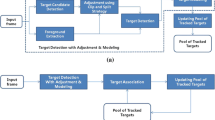Abstract
Target re-identification from across cameras is a difficult problem in multi-camera surveillance, which needs to be urgently solved. Traditional solutions, in addition to relying on the statistical characteristics of targets’ appearance, are more often using excellent measurement algorithms. Among many such algorithms, the Keep It Simple and Stupid Measure Learning (KISSME) algorithm based on statistical probability is an outstanding one. But it has a problem that the eigenvalue is not stable, and the actual matching rate is relatively low. So, in this paper, we optimize the measurement algorithms based on large scale Keep It Simple and Stupid (KISS) measure learning. From elements, such as inadequate sample, size and smaller or larger eigenvalues, we introduce eigenvalue stabilization technique, and finally form our algorithm which can be called Adaptive Incremental Keep It Simple and Stupid Measure Learning (AIKISSME). Finally, through many experiments based on Viewpoint Invariant Pedestrian Recognition (VIPeR) and by comparing with other algorithms, this work concludes that AIKISSME achieves the best overall performance.




Similar content being viewed by others
References
Farenzena M, Bazzani L, Perina A (2010) Person re-identification by symmetry-driven accumulation of local features. In: Computer Vision and Pattern Recognition(CVPR), San Francisco, USA, pp 2360-2367
Han H, Cao W, Gong T (2015) The establishment of correlative degree in target re-identification based on earth mover’s distance. Journal of Huazhong University of Science and Technology(Natural Science Edition) 43:435–439 (in Chinese)
Ma B, Su Y, Jurie F (2012) Local descriptors encoded by fisher vectors for person re-identification. In: European Conference on Computer Vision (ECCV). Lecture Notes in Computer Science, 7583: 413-422
Brun L, Conte D, Foggia P (2011) People re- identification by graph kernels methods. In: \(8^{{\rm th}}\) International Workshop on Graph-Based Representations in Pattern Recognition. Lecture Notes in Computer Science, 6658:285-294
Gray D, Tao H (2008) Viewpoint invariant pedestrian recognition with an ensemble of localized features. In: European Conference on Computer Vision. Lecture Notes in Computer Science, 5302: 262-275
Dikmen M, Akbas E, Huang TS (2010) Pedestrian recognition with a learned metric. In: Asian Conference on Computer Vision, Lecture Notes in Computer Science 6495:501–512
Mazzon R, Tahir SF, Cavallaro A (2012) Person re-identification in crowd. Pattern Recognition Letters 33(14):1828–1837
Nekkaa M, Boughaci D (2015) A memetic algorithm with support vector machine for feature selection and classification. Memetic Computing 7(1):59–73
Köstinger M, Hirzer M, Wohlhart P (2012) Large scale metric learning from equivalence constraints. In: 2013 IEEE Conference on Computer Vision and Pattern Recognition. pp 2288-2295
Moghaddam B, Jebara T, Pentland A (2000) Bayesian face recognition. Pattern Recognition 33(11):1771–1782
Tao D, Jin L, Wang Y (2013) Person Re-Identification by Regularized Smoothing KISS Metric Learning. IEEE Transactions on Circuits & Systems for Video Technology 23(10):1675–1685
Jain AK, Chandrasekaran B (1982) Dimensionality and sample size considerations in pattern recognition practice. In: Krishnaiah PR, Kanal LN, Handbook of Statistics, pp 835-855
Dong WW (2006) Algorithms research on feature extraction and classifiers of high-dimensional and small sample size data. Nanjing University of Science and Technology. PhD Thesis, pp 15-30
Liong VE, Ge Y, Lu J (2015) Discriminative regularized metric learning for person re-identification. In: 2015 International Conference on Biometrics, pp 52-57
Nappi M, Wechsler H (2012) Robust re-identification using randomness and statistical learning: Quo Vadis. Pattern Recognition Letters 33(14):1820–1827
Peng TD (2014) Small-sample Learning for High- dimensional Problems. South China university of technology. PhD Thesis, pp 99-109
Zhen L (2013) Learning locally-adaptive decision functions for person verification. In: IEEE Computer Society Conference on Computer Vision and Pattern Recognition, pp 3610-3617
Hirzer M, Beleznai C, Roth PM (2011) Person Re-identification by Descriptive and Discriminative Classification. In: Image Analysis. Lecture Notes in Computer Science, 6688:91-102
Yamauchi K (2009) Optimal incremental learning under covariate shift. Memetic Computing 1(4):271–279
Paisitkriangkrai S, Shen C (2015) Learning to rank in person re-identification with metric ensembles. In: 2015 IEEE Conference on Computer Vision and Pattern Recognition, pp 1846-1855
Cheng DS, Cristani M, Stoppa M (2011) Custom pictorial structures for re-identification. In: British Machine Vision Conference, (68):1-11
Hu Y, Liao S, Lei Z (2013) Exploring structural information and fusing multiple features for person re-identification. In: IEEE Conference on Computer Vision and Pattern Recognition Workshops, pp 794-799
Zhao R, Ouyang W, Wang X (2013) Unsupervised salience learning for person re-identification. In: 2013 IEEE Conference on Computer Vision and Pattern Recognition, pp 3586-3593
Yong ZM, Ming WZ, Chang T (2014) Fusing Appearance Statistical Features for Person Re-identification. Journal of Electronics & Information Technology 36(8):1844–1851
Prosser B, Zheng WS, Gong S (2010) Person re-identification by support vector ranking. In: British Machine Vision Conference, pp 1-11
Zheng WS, Gong S, Xiang T (2013) Re-identification by relative distance comparison. IEEE Transactions on Pattern Analysis and Machine Intelligence 35(3):653–668
Pedagadi S, Orwell J, Velastin S (2013) Local fisher discriminant analysis for pedestrian re-identification. In: IEEE Computer Society Conference on Computer Vision and Pattern Recognition, pp 3318-3325
Pang Y, Shi X, Jia B (2015) Multiway histogram intersection for multi-target tracking. In: 18th International Conference on Information Fusion, pp 1938-1945
Acknowledgments
This work was supported by the National Nature Science Foundation of China (No. 61305014), China Scholarship Council (201508310033), Innovation Program of Shanghai Municipal Education Commission (14ZZ156), the Natural Science Foundation of Shanghai, China (No. 13ZR1455200), “Chen Guang” project supported by Shanghai Municipal Education Commission and Shanghai Education Development Foundation (No. 13CG60), Funding Scheme for Training Young Teachers in Shanghai Colleges (No. ZZGJD13006), the connotative construction projects of Shanghai local colleges in the 12th 5-Year (nhky-2014-12, nhrc-2015-11).
Author information
Authors and Affiliations
Corresponding author
Rights and permissions
About this article
Cite this article
Cao, W., Han, H., Sun, Xk. et al. Target re-identification based on adaptive incremental KISS measure learning. Memetic Comp. 9, 23–30 (2017). https://doi.org/10.1007/s12293-016-0196-z
Received:
Accepted:
Published:
Issue Date:
DOI: https://doi.org/10.1007/s12293-016-0196-z




